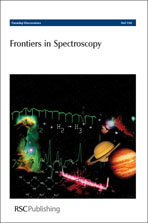Photoelectron–photofragment coincidence studies of NO−-X clusters (X = H2O, CD4)
Abstract
The dissociative photodetachment of NO−(H2O)and NO−(CD4) anion clusters was studied at 775 nm (1.60 eV) using photoelectron–photofragment coincidence
- This article is part of the themed collection: Frontiers in Spectroscopy

 Please wait while we load your content...
Please wait while we load your content...